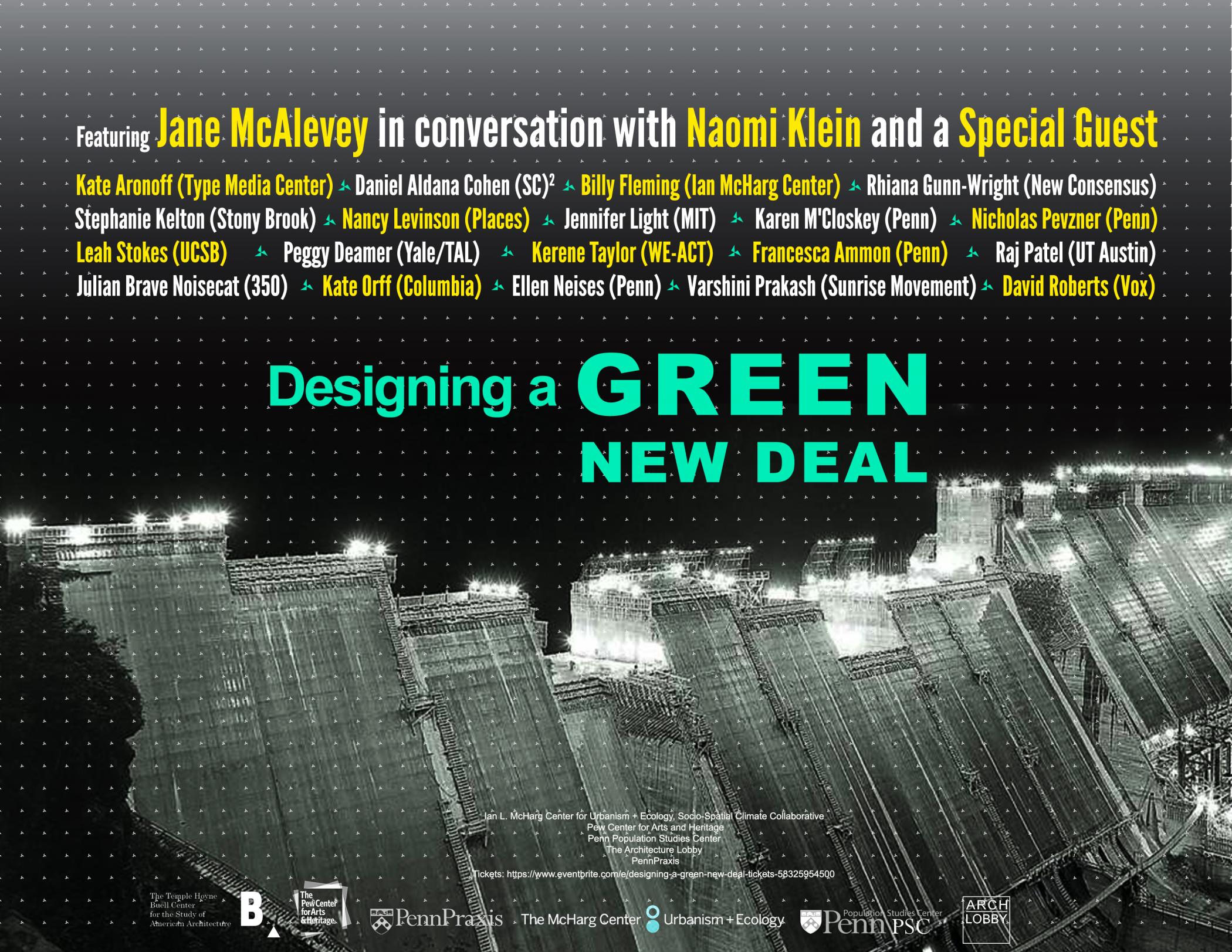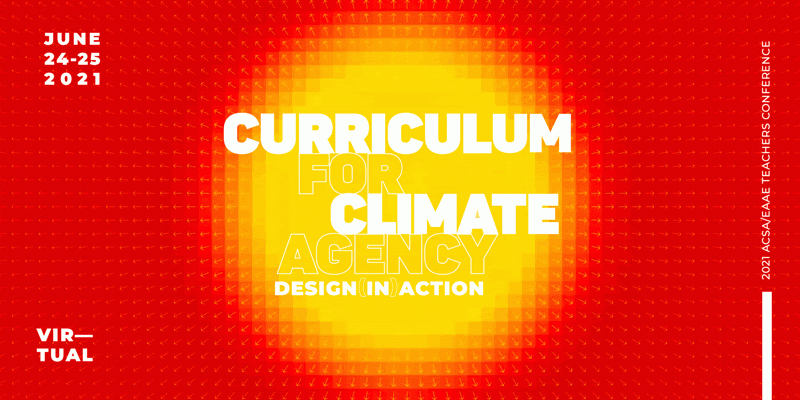Infrastructure in
America
It's Simple: Histories of Architecture and/for the Environment
Avery Hall Room 114, 1pm
This afternoon conference at Columbia GSAPP was co-organized by the Canadian Centre for Architecture (CCA), the Temple Hoyne Buell Center for the Study of American Architecture, and the Society of Fellows/Heyman Center for the Humanities at Columbia University.
Speakers included:
Introductions by Reinhold Martin, Columbia University, and Mirko Zardini, CCA
Daniel Barber, University of Pennsylvania
Aleksandr Bierig, Harvard University
Nerea Calvillo, Warwick University
Jiat-Hwee Chang, National University of Singapore
Isabelle Doucet, Manchester University
Hannah le Roux, University of the Witwatersrand
Kiel Moe, McGill University
Paulo Tavares, Universidade de Brasília
Response by Meredith TenHoor, Pratt Institute
Panel moderated by Meredith TenHoor and Kim Förster, CCA
Some profit from climate change, but many more suffer its consequences. It’s that simple: any history of anthropogenic planetary transformation is therefore also a history of inequality, injustice, and struggle.
Arguing that architecture needs an environmental history, the Canadian Centre for Architecture organized, with generous support from the Andrew W. Mellon Foundation, the multidisciplinary, collaborative research project ”Architecture and/for the Environment.” But what should this history look like? Around whose priorities should its objects of inquiry be defined and assembled? What truths should it seek?
As a part of the CCA’s research project and in conjunction with the Buell Center’s “Power: Infrastructure in America” research initiative, this afternoon event offered new directions and agendas for environmental histories of architecture that combine a planetary perspective with an assertion that national centers of power, particularly those in the United States, continue to hold outsize influence and responsibility.
This event followed the CCA public seminar on 9 June, 2018, “It’s Complicated,” during which Mellon researchers and invited scholars interrogated paired concepts of Energy/Power, Control/Systems, Body/Exposure, and Post-human/Nature.
With “It’s Simple,” the CCA and the Buell Center proposed that there are few winners and mostly losers in the Anthropocene, and that architectural—indeed environmental—historiography must begin by acknowledging this fact. Though the narratives might be complex, the imperative is simple.
This afternoon event was preceded by a pop-up display organized by the CCA on the fourth floor of Avery Hall entitled ”‘You Must Choose Between Oxygen or Wealth.’“ Shown from October 8–19, 2018, it highlighted the CCA’s recent efforts to examine environmental issues through distinct yet interlinked curatorial approaches. The display’s title was taken from the artist Douglas Copeland’s Slogans for the Twenty-First Century.
Daniel Barber is Associate Professor of Architecture at the University of Pennsylvania, Philadelphia, United States, as well as a Humboldt Fellow at the Max Planck Institute in Berlin, Germany. His publications include A House in the Sun: Modern Architecture and Solar Energy in the Cold War (2016) and Modern Architecture and Climate: Design Before Air Conditioning (2020).
Aleksandr Bierig is a PhD candidate studying urban and architectural history at the Harvard Graduate School of Design, Cambridge, United States. His research concerns interactions between the built environment, the natural environment, and political economy in eighteenth- and nineteenth-century Britain.
Nerea Calvillo is Assistant Professor at the Centre for Interdisciplinary Methodologies at Warwick University, Coventry, United Kingdom, where she investigates the material, technological, political, and social dimensions of environmental pollution.
Jiat-Hwee Chang is Associate Professor of Architecture at the National University of Singapore and has written and co-edited several books, including A Genealogy of Tropical Architecture: Colonial Networks, Nature and Technoscience (2016).
Isabelle Doucet is professor of architectural theory and history at Chalmers University of Technology, Gothenburg, Sweden, where her research focuses on the relationship between (urban) politics, aesthetics, and social responsibility in architecture. She is the author of The Practice Turn in Architecture. Brussels after 1968 (2015) and she co-edited with Hélène Frichot the thematic issue “Resist Reclaim Speculate: Situated Perspectives on Architecture and the City” (Architectural Theory Review, 2018).
Kiel Moe is an architect and educator. At the time of the conference, he was the Gerald Sheff Professor of Architecture at McGill University, Montreal, Canada, where he taught design and advanced construction as energetic and environmental processes. He has also held positions at the Massachusetts Institute of Technology, Harvard Graduate School of Design, and others.
Hannah le Roux is an architect, curator, and educator at the University of the Witwatersrand, Johannesburg, South Africa. Her work revisits the modernist project in architecture and considers how its transformation under the influence of the agency of African users presents a conceptual model for contemporary design.
Paulo Tavares is an architect based in Brasília, Brazil, where he teaches at the Faculdade de Arquitetura e Urbanismo, Universidade de Brasília. He runs the design and research agency autonoma, is a long-term collaborator of Forensic Architecture, and was a co-curator of Chicago Architecture Biennial 2019.
Image: Lynne Cohen. Spa, 2003. Chromogenic color print. PH2017:0051. Canadian Centre for Architecture. Gift of Andrew Lugg © Lynne Cohen
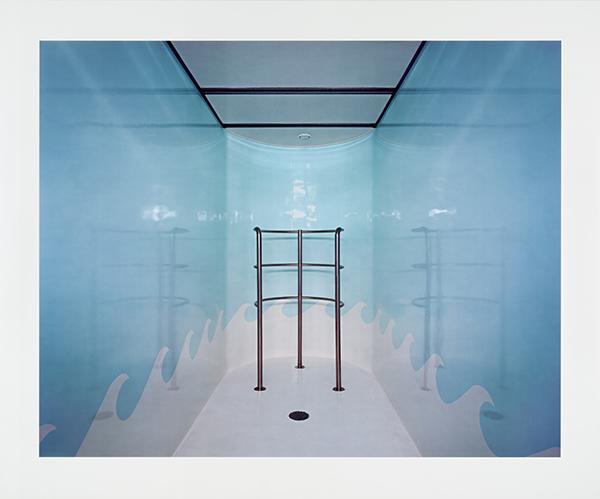
Lynne Cohen. Spa, 2003. Chromogenic color print. PH2017:0051. Canadian Centre for Architecture, Gift of Andrew Lugg. (Lynne Cohen)
The Green New Deal: A Public Assembly
On Sunday, November 17, 2019, at the Queens Museum, “The Green New Deal: A Public Assembly” gathered a wide array of advocates, organizers, and elected officials to explore the GND’s relationship to society, policy, and the built environment.
Climate change is a crisis of unevenly experienced and systemic injustices that asks hard questions of scholars, practitioners, and community members alike. The Green New Deal—most famously as drafted in US H. Res. 109 and S. Res. 59, but echoed by elected officials and activists around the world—addresses these questions head-on, linking equity, the environment, and the economy to the transformations necessitated by the climate crisis.
“The Green New Deal: A Public Assembly” focused on modeling democratic debates that seriously consider the ambitions and challenges of the GND by thinking systemically and across scales. The public event included morning workshops and an afternoon series of discussions to encourage exchange among invited guests representing a range of disciplines as well as the general public. Spanish interpretation services were provided for the afternoon assembly, beginning at 1:00pm.
Located at the Queens Museum—home of the Panorama of the City of New York and in the heart of the nation's most diverse county—“The Green New Deal: A Public Assembly” took place within US Congressional District NY 14, jurisdiction of the Green New Deal House Resolution’s sponsor, Representative Alexandria Ocasio-Cortez, who joined the assembly with a pre-recorded video.
The representative from NY-14, Alexandria Ocasio-Cortez, responded to three questions posed to all event participants.
The event was organized by the Queens Museum, the American Institute of Architects New York (AIA New York), the Architecture Lobby, Francisco J. Casablanca (founder of the Instagram page "¿Quién Nos Representa?"), and Gabriel Hernández Solano (a Green New Deal Organizer), together with the Temple Hoyne Buell Center for the Study of American Architecture at Columbia University. At the Buell Center, “The Green New Deal: A Public Assembly” formed part of the project “Power: Infrastructure in America,” within which the Center organized a series of research, curriculum, and programming initiatives to consider the social, technical, and political contours of the ambitious—but still largely undefined—proposal.
Schedule
10:00 Welcome / Bienvenida
10:30–12:00 Workshops / Talleres
1:00 Welcome (back) / Segunda bienvenida
- Language Justice Orientation by Caracol Language Coop
- Land Acknowledgment by Tecumseh Caesar
- Debra Wimpfheimer (Chief Operating Officer, Queens Museum)
1:15 On a Green New Deal / Sobre un Green New Deal
- Randy Abreu, Office of Representative Alexandria Ocasio-Cortez
2:00 On Energy and Power / Sobre energía y poder
Presentation by morning discussion group
- Samantha Josaphat (National Organization of Minority Architects)
- Forrest Meggers (Architecture and Engineering, Princeton University)
- Priya Mulgaonkar (New York City Environmental Justice Alliance)
- Matt Peterson (Woodbine)
- Anandi A. Premlall (educator in urban permaculture, SustyQ)
- Gaya Sriskanthan (climate, energy, and environmental justice advocate)
- Sean Sweeney (Labor and Urban Studies, City University of New York)
- Claudia Zamora Valencia (New Immigrant Community Empowerment)
2:20 Remarks by Costa Constantinides (City Council, 22nd District)
2:30 Public discussion
3:00 On Transportation and Power / Sobre transportación y poder
Presentation by morning discussion group
- Ellis Calvin (Regional Plan Association)
- Jon Forster (organized labor policy advocate)
- Oscar Oliver Didier (New York City Department of City Planning, the Bronx)
- Leah Meisterlin (Urban Planning, Columbia University)
- Juan Restrepo (Transportation Alternatives Queens)
- Jennifer Scarlott (Bronx Climate Justice North)
3:20 Remarks by Catalina Cruz (State Assembly, 39th District)
3:30 Public discussion
4:15 On Government and Power / Sobre gobierno y poder
Presentation by morning discussion group:
- Xiye Bastida (Fridays for Future)
- Tecumseh Ceaser (artist and cultural consultant)
- Ama Francis (Sabin Center, Columbia University)
- Diana Hernández (Public Health, Columbia University)
- Aurash Khawarzad (artist, educator, urban planner)
- Monxo Lopez (South Bronx Unite)
4:35 Remarks by Jessica Ramos (State Senator, 13th District)
4:45 Public Discussion
5:15 Concluding remarks and discussion / Conclusión, comentarios y discusiones
6:00 Reception / Recepción
---
“The Green New Deal: Una Asamblea Pública” convocó una selección amplia de especialistas, organizadores, y oficiales elegidos para explorar la relación entre el "Green New Deal," la sociedad, la política, y el ambiente construido.
El cambio climático, siendo una crisis desigual y de injusticias sistemáticas, es un desafío lleno de interrogantes, tanto para académicos, profesionales, y miembros de la comunidad por igual. El Green New Deal—mejor conocido por su redacción en US H. Res. 109 y S. Res. 59, y que resuena con los oficiales elegidos y activistas alrededor del mundo—aborda esas preguntas de una forma directa, enlazando la equidad, el medio ambiente, y la economía a las transformaciones necesarias para enfrentar crisis climática.
“The Green New Deal: Una Asamblea Pública” se enfocó en modelar debates democráticos que consideran seriamente las ambiciones y los retos del GND, pensando sistemáticamente y en varias escalas. Este evento público incluyó talleres de trabajo en la mañana, en la tarde y una serie de discusiones para fomentar un intercambio productivo entre los invitados de distintas disciplinas y el público general. Se proveyó servicios de interpretación en español para la asamblea de la tarde, comenzando a las 13:00.
Al estar ubicado en el Museo de Queens—situado en el corazón del condado más diverso del país y donde podemos encontrar la maqueta “Panorama of the City of New York”—“The Green New Deal: Una Asamblea Pública” se llevó a cabo dentro del Distrito NY 14 del Congreso de los Estados Unidos, jurisdicción de la patrocinadora de la Resolución del Green New Deal, la Representante Alexandria Ocasio-Cortez, quien se unió a la discusión por un video pre-grabado (arriba).
Este evento estuvo organizado por el Museo de Queens, el Instituto Americano de Arquitectos de Nueva York (AIANY), el Lobby de Arquitectura, Francisco J. Casablanca (fundador de la página de Instagram "¿Quién Nos Representa?"), y Gabriel Hernández Solano (organizador del Green New Deal), en conjunto con el Temple Hoyne Buell Center for the Study of American Architecture en Columbia University. En el Buell Center, “The Green New Deal: Una Asamblea Pública” formó parte del proyecto “Power: Infrastructure in America” (Poder: Infraestructura en América), dentro del cual el Centro organizó una serie de iniciativas curriculares, investigativas, y programáticas que consideran los entornos sociales, técnicos, y políticos de una propuesta ambiciosa, pero en gran parte indefinida.
Horario arriba
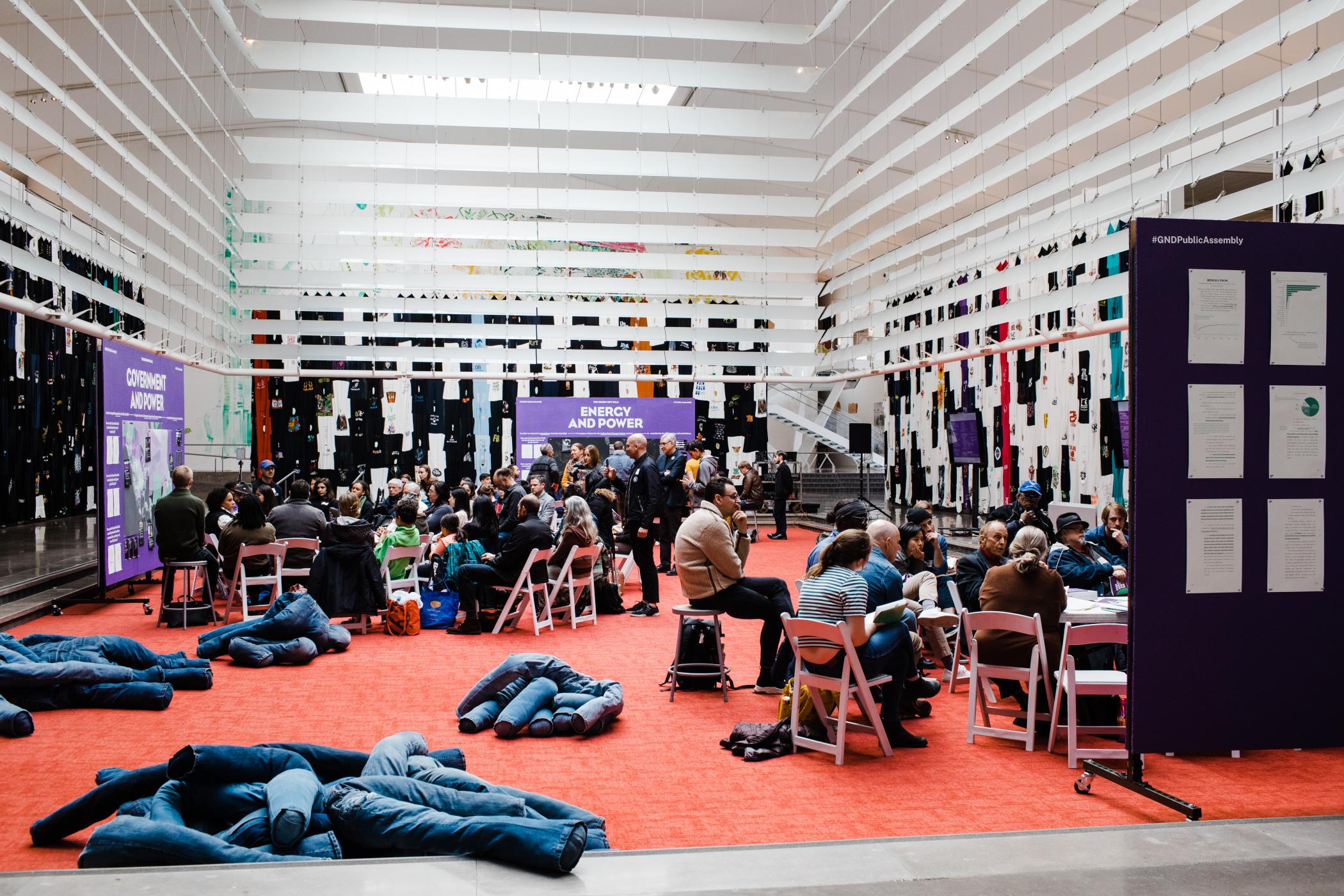
"Green New Deal: Public Assembly" (Corey Torpie)
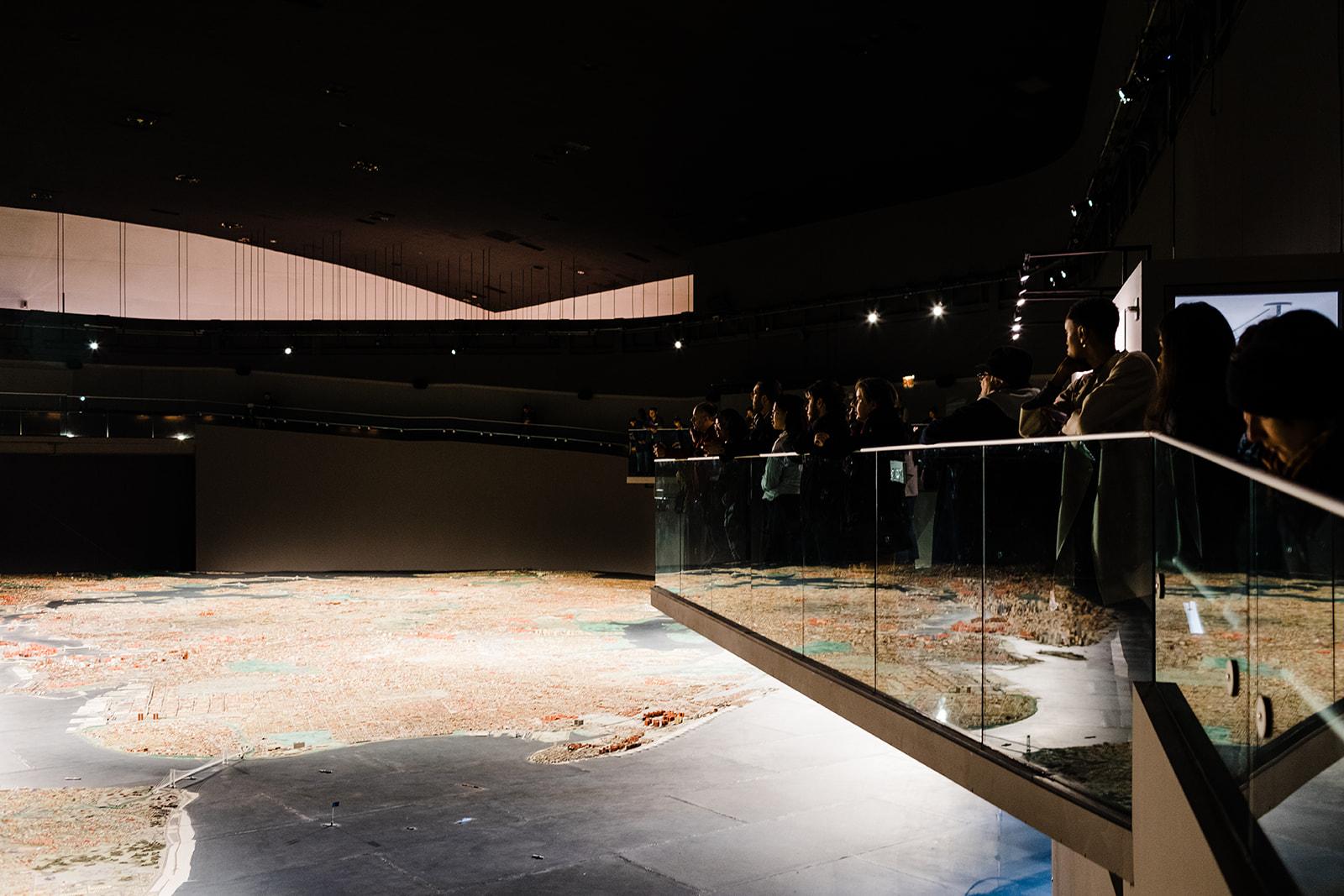
"Green New Deal: Public Assembly" begins around a Panorama of the City of New York (Corey Torpie)
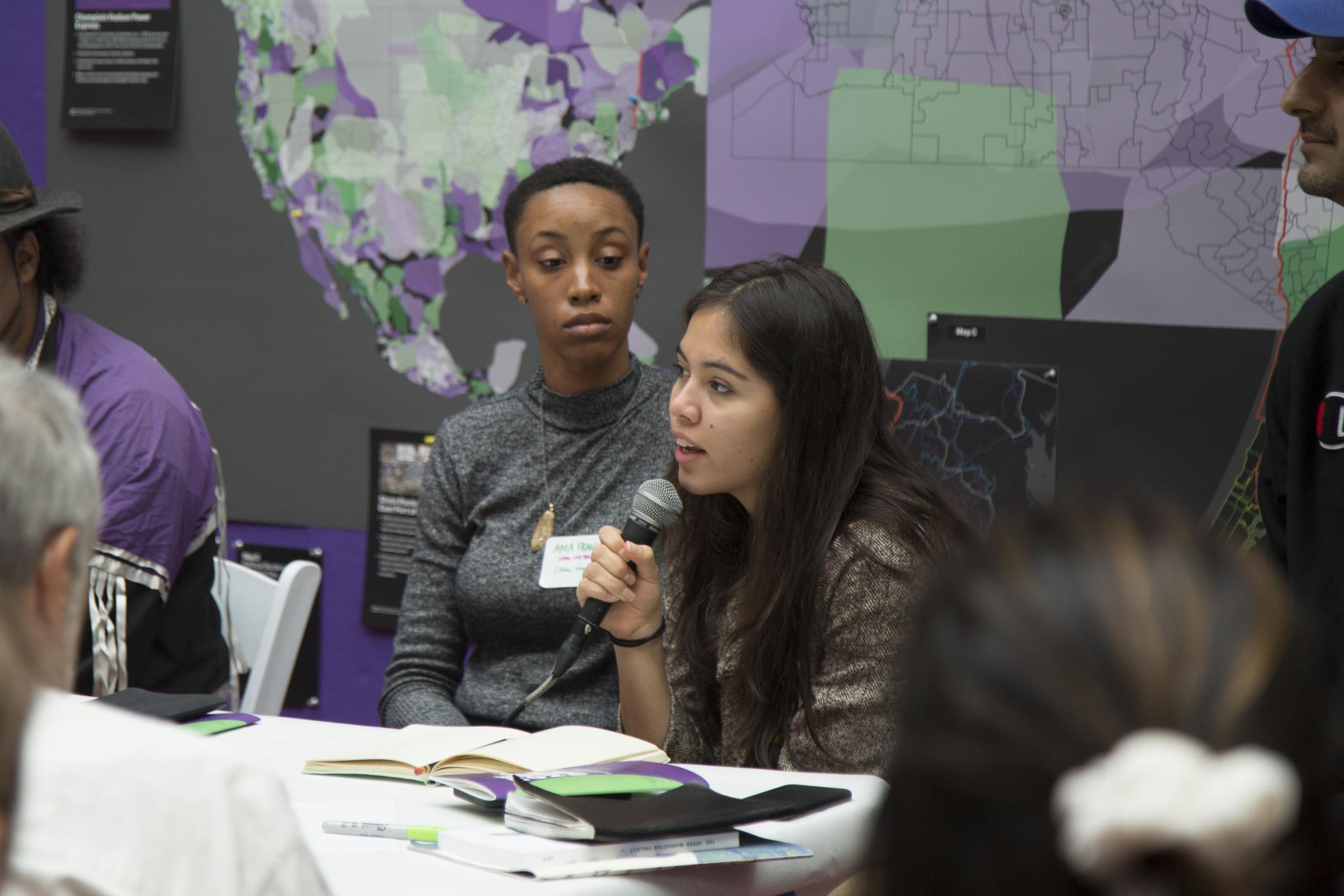
Xiye Bastida participates in the "Democracy and Power" workshop (Claudia Kleffmann)
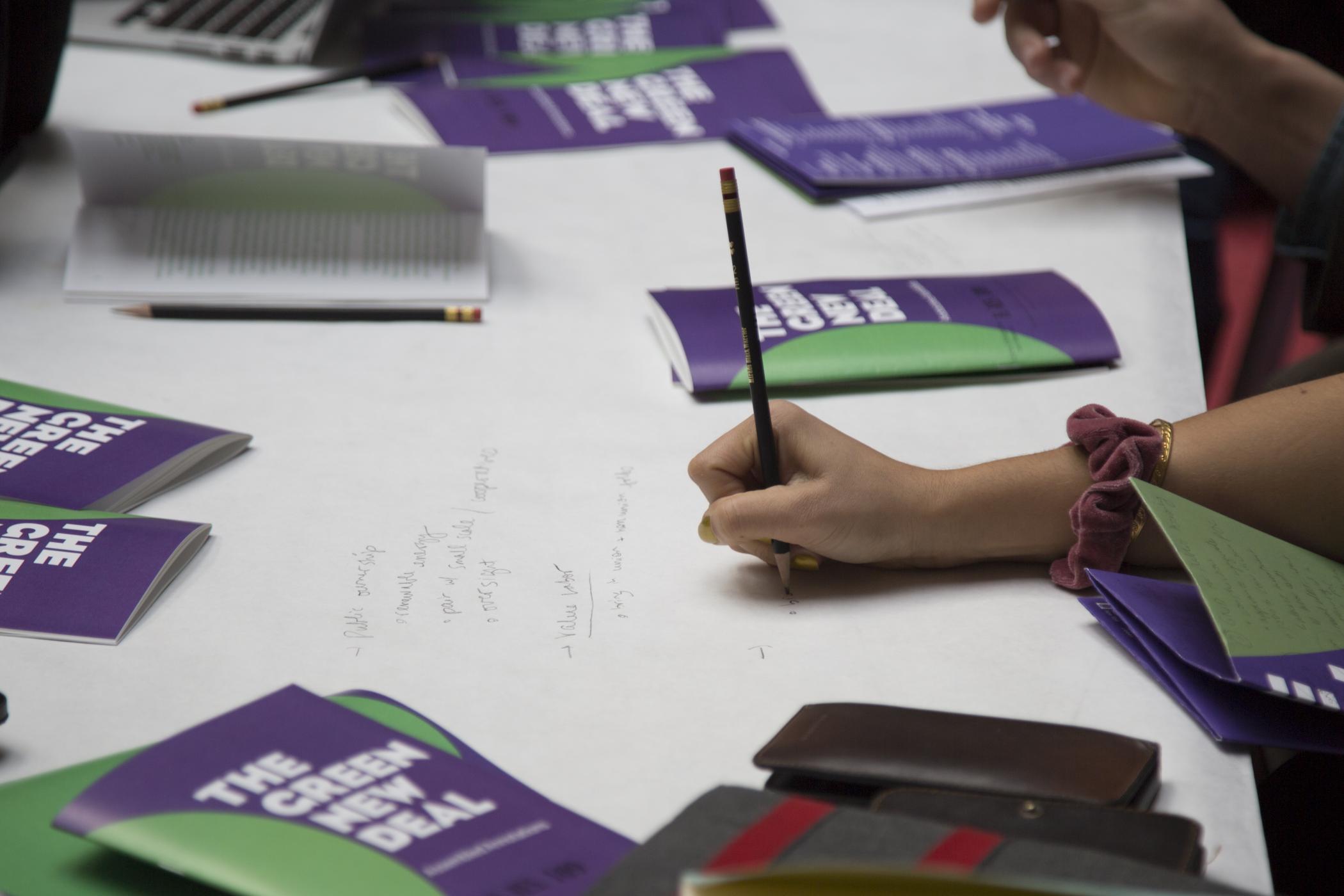
Workshop participants taking notes alongside "The Green New Deal: Assembled Annotations" (Claudia Kleffmann)
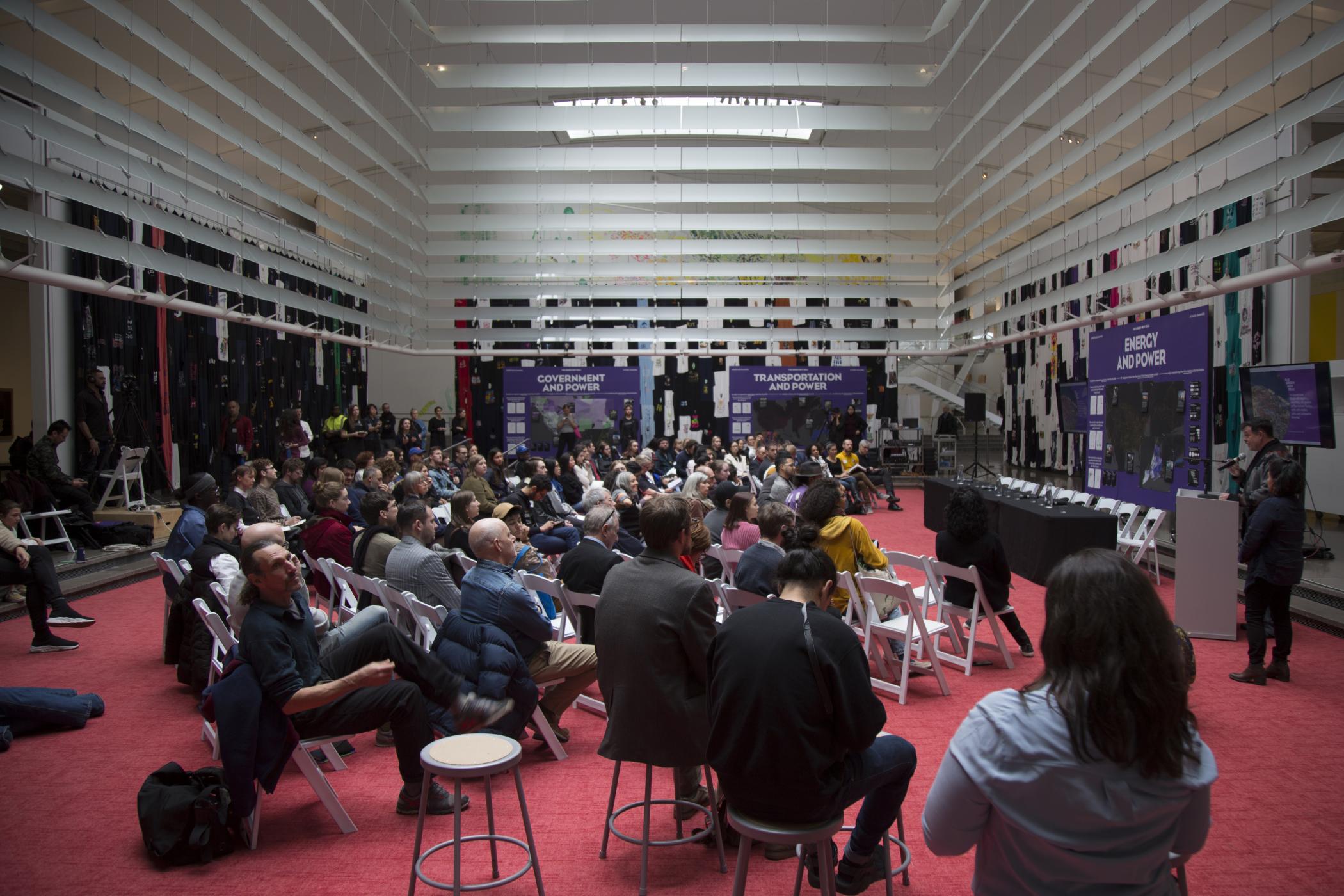
Caracol Language Cooperative gives a language justice orientation (Claudia Kleffmann)
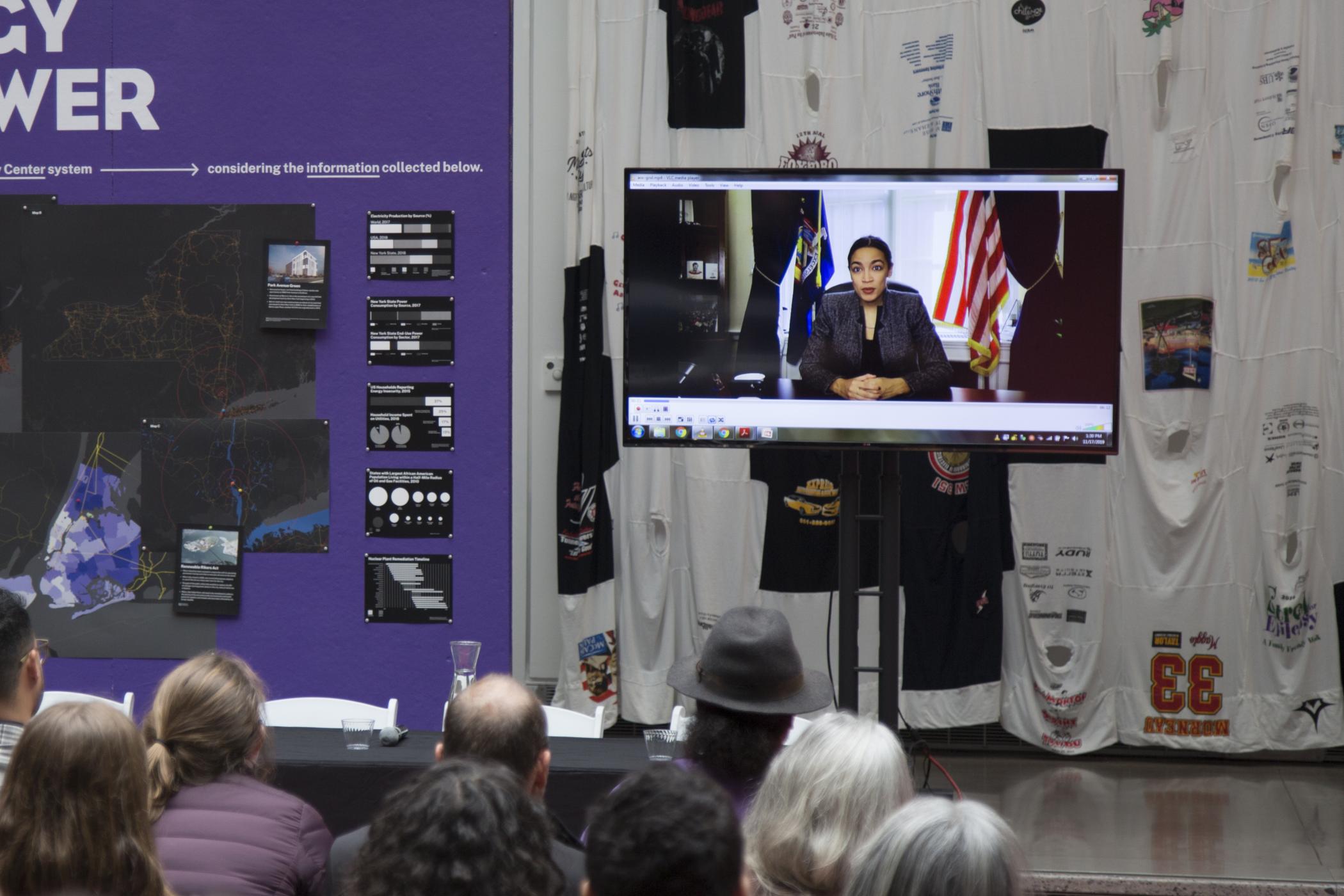
Representative Alexandria Ocasio-Cortez addresses the audience (Claudia Kleffmann)
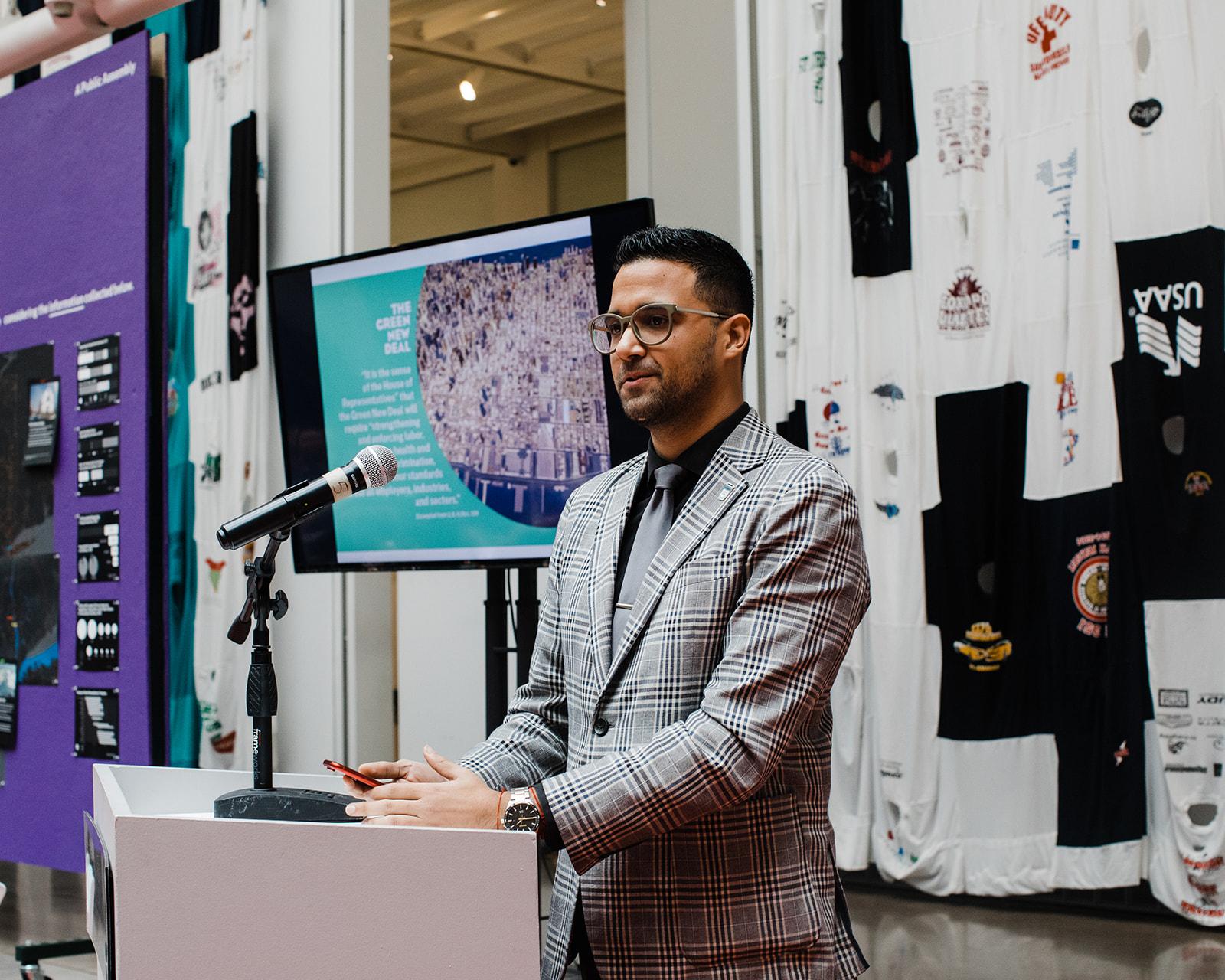
Andy Abreu discusses a Green New Deal (Corey Torpie)
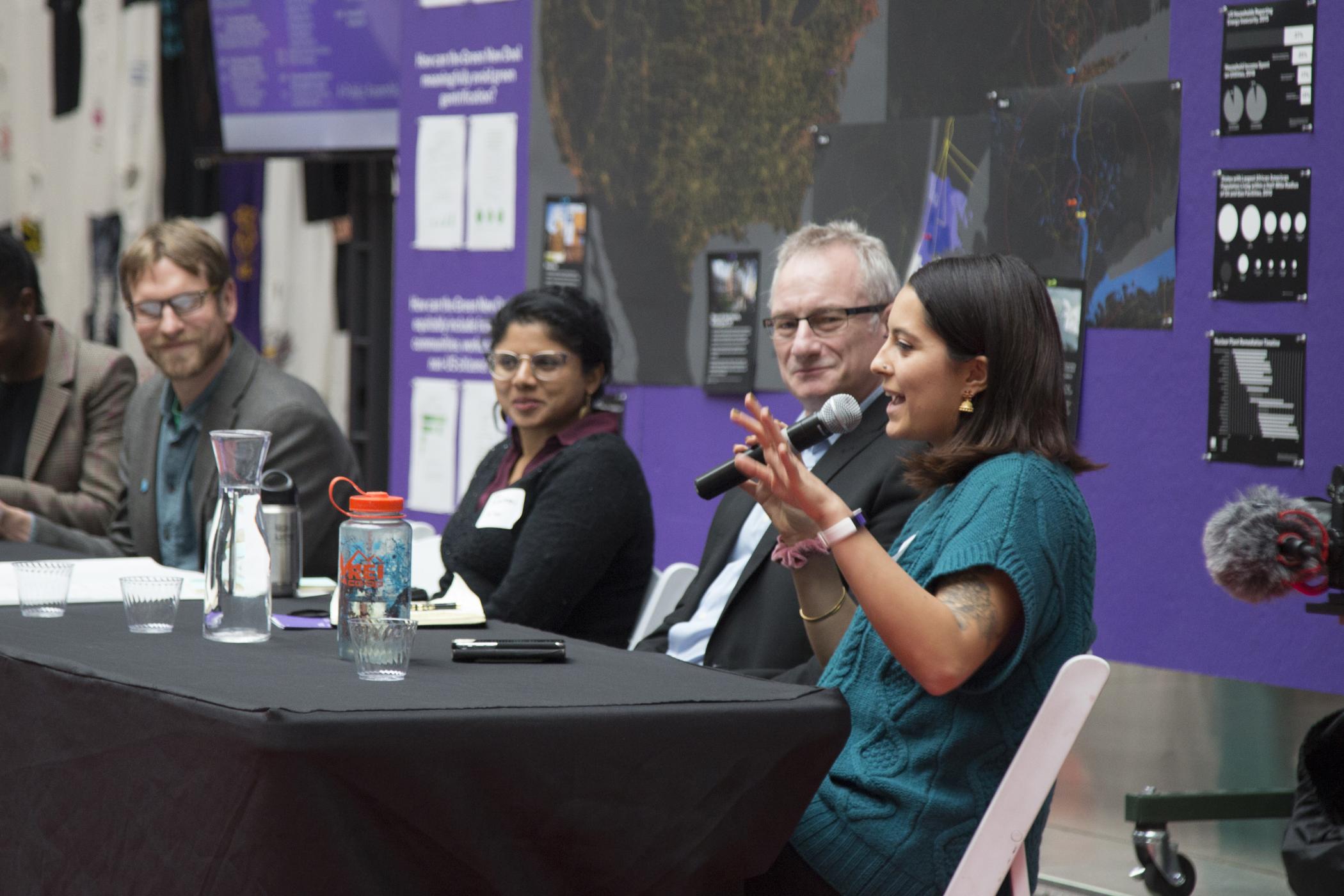
Priya Mulgaonkar on "Energy and Power" (Claudia Kleffmann)
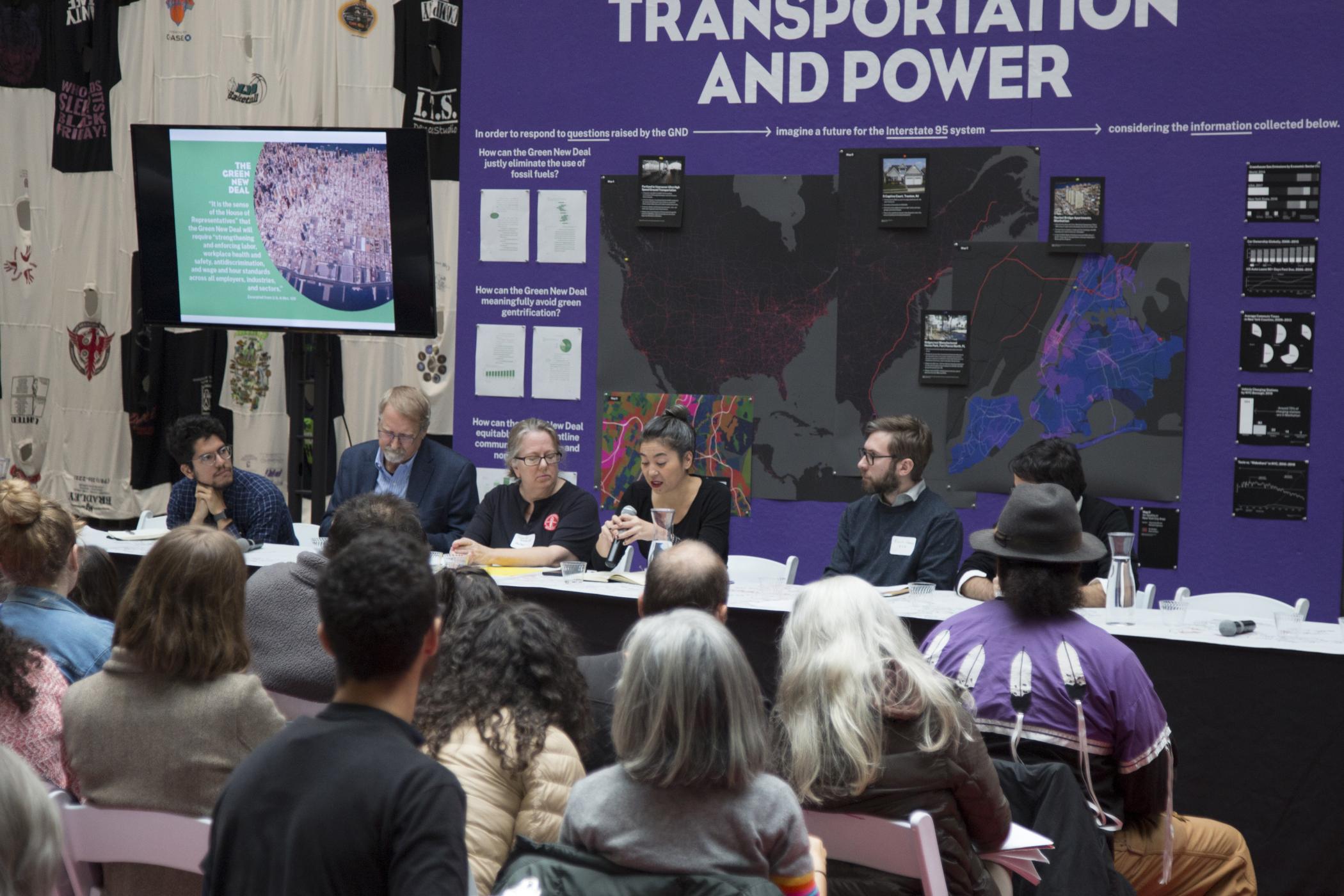
Leah Meisterlin discusses "Transportation and Power" (Claudia Kleffmann)
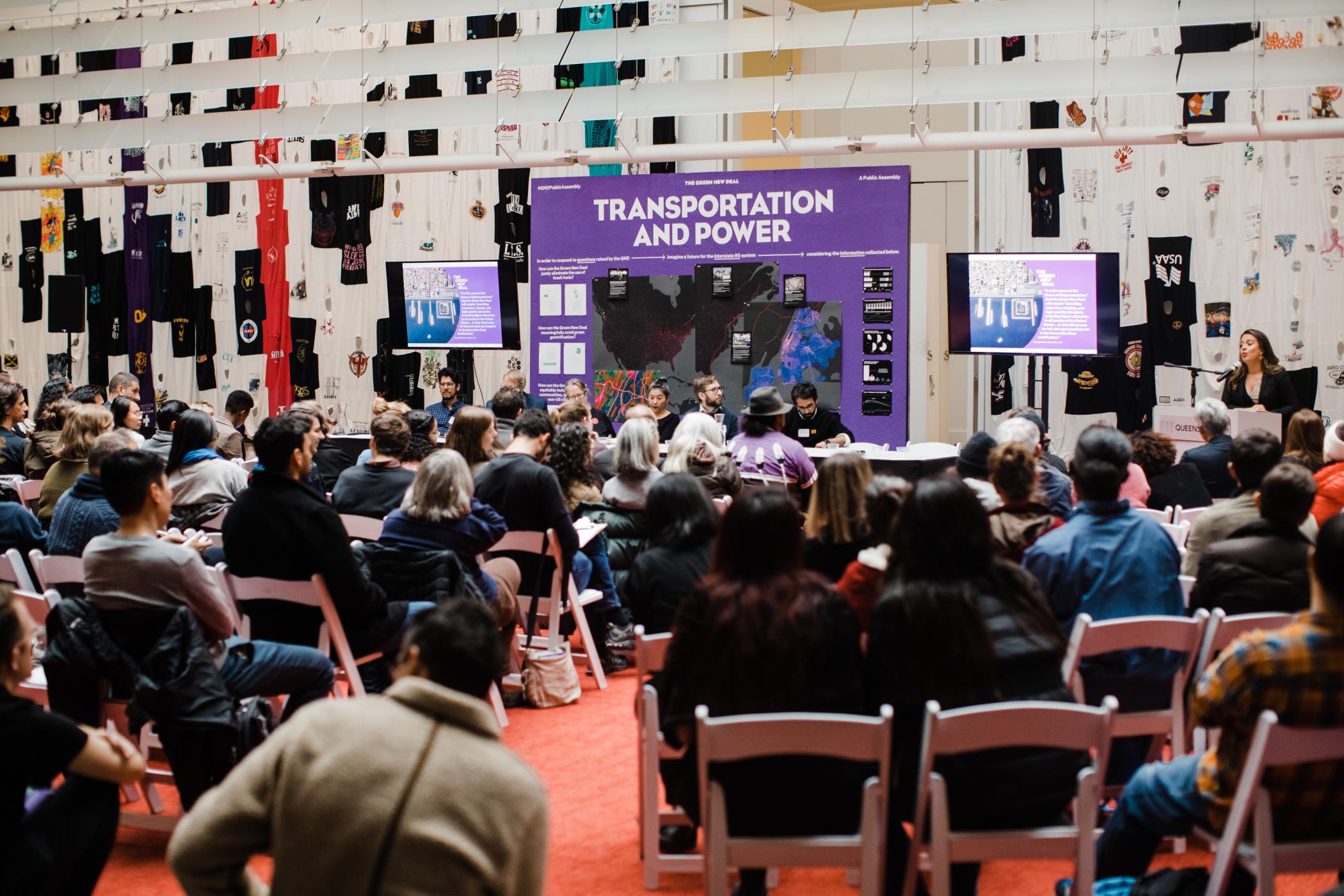
Assemblywoman Catalina Cruz on "Transportation and Power" (Corey Torpie)
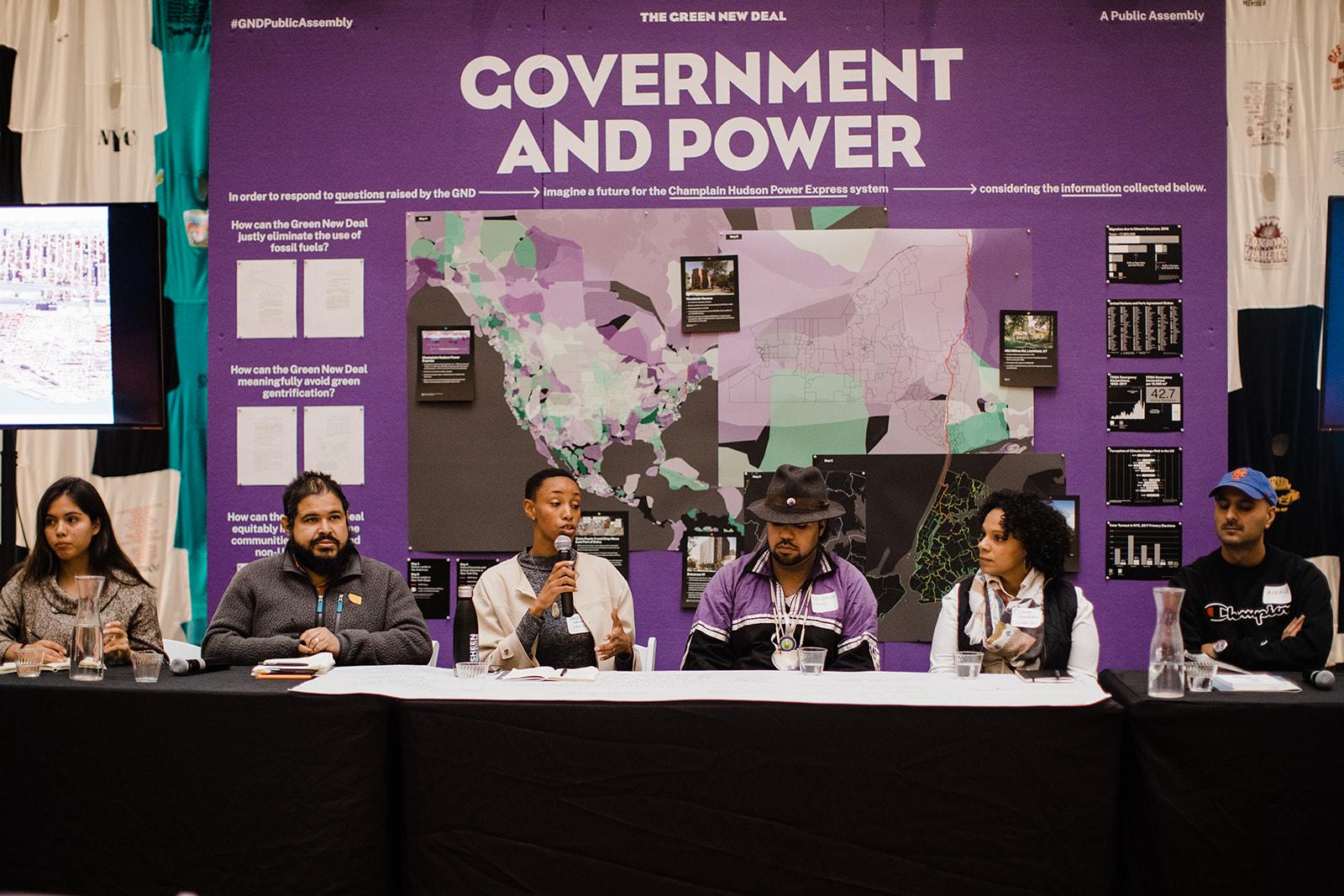
"Government and Power" (Corey Torpie)
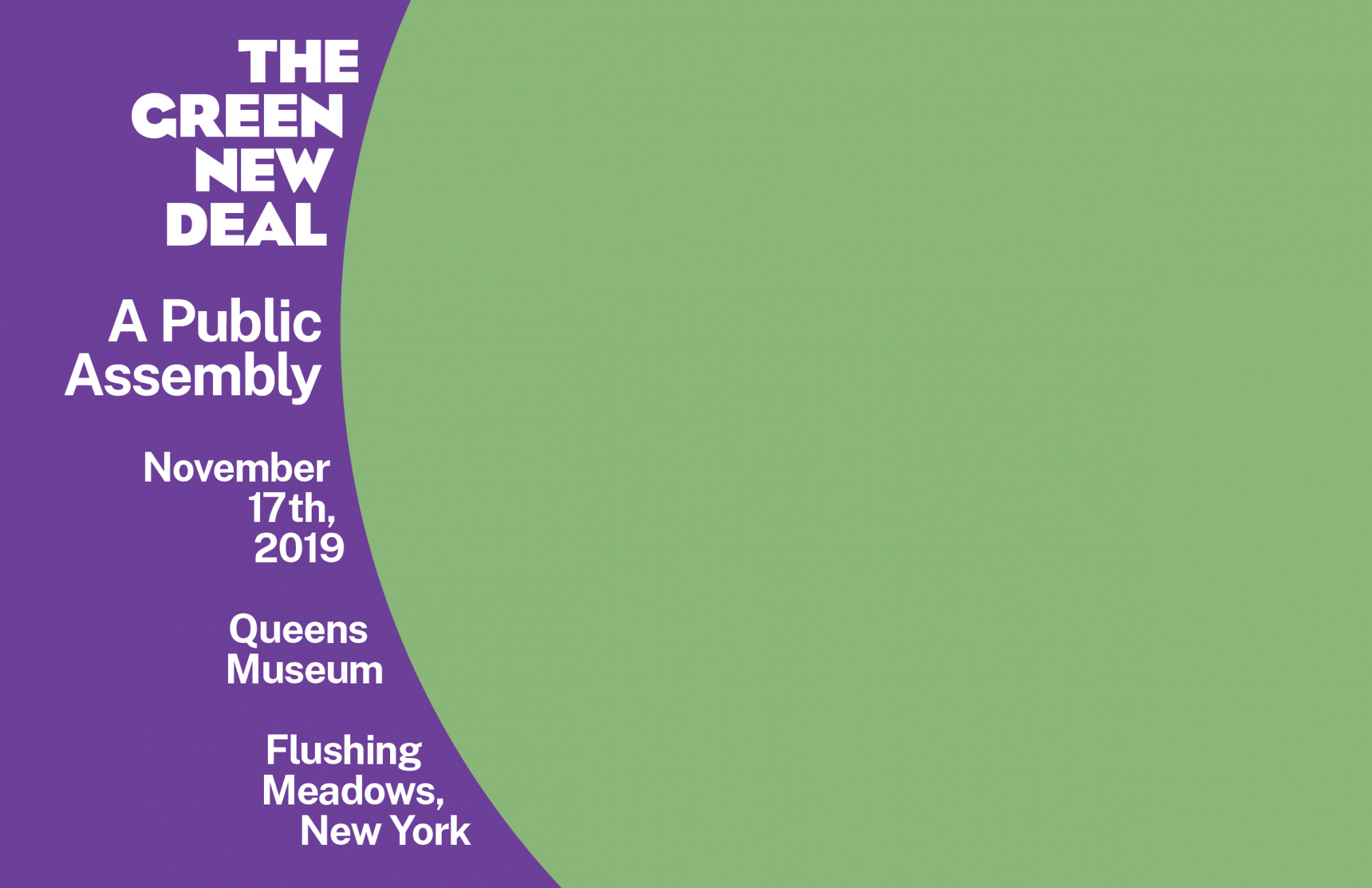
Democracy in Retreat? Master Planning in a Warming World
The climate crisis is changing the world. Some people are moving in the face of rising seas and extreme weather, and others are redesigning the places they live. But those making such plans and those most affected by them are not always the same. The challenges posed by climate change thus force architects, planners, engineers, and others charged with imagining the future of their communities to contend with enduring questions of democracy and justice.
This conference foregrounded Louisiana’s experience with these challenges, because on the Gulf Coast, the climate had already changed. New designs and infrastructures had reshaped how Louisianans live, just as evacuation, eviction, and emigration in the face of rising seas redefined where they live. All the while, as the United States confronts climate change it is already riven by stark inequalities. Escaping critical interrogation, technocratic plans promulgated in the name of “resilience” can not only reproduce, but exacerbate existing injustices across the country and beyond its borders. Many policies that promise security for some cause suffering for others. But must there be winners and losers in the pursuit of safety, justice, and democracy?
This event brought together architects, planners, scholars, artists, and others whose work engages with the challenges of planning for climate change. Using Louisiana as the case to “think with,” participants worked comparatively to evaluate the perils and promises of risk and retreat, given the imperatives of justice and democracy.
SCHEDULE
9:00 — Introductory Remarks
- ByWater Institute, Tulane University
- Temple Hoyne Buell Center for the Study of American Architecture, Columbia University
9:30 — Defining and Managing Risk
Who, and what, is at risk?
- Craig Colten, Geography and Anthropology, Louisiana State University
- Traci Birch, Coastal Sustainability Studio, Louisiana State University
- Zachary Lamb, Princeton Mellon Fellow in Urbanism and the Environment
- Monique Verdin, Another Gulf is Possible
- Respondent: Liz Koslov, Urban Planning, Institute of the Environment and Sustainability, University of California, Los Angeles
- Moderator: Andy Horowitz, Assistant Professor, Department of History, School of Liberal Arts, Tulane University
11:15 — Evacuation, Emigration, Eviction
Who leaves their home—when, why, and how?
- Jay Arena, Sociology, College of Staten Island, City University of New York (CUNY)
- Monica Farris, Center for Hazard Assessment, Response and Technology (CHART), University of New Orleans
- Farrah Cambrice, Sociology, Prairie View A&M University
- Andreanecia Morris, Greater New Orleans Housing Alliance
- Respondent: Zaire Dinzey-Flores, Sociology, Rutgers
- Moderator: Fallon Samuels Aidoo, Jean Brainard Boebel Chair in Historic Preservation, Assistant Professor of Planning & Urban Studies, University of New Orleans
2:00 — Greenwashing
How do technocratic claims obscure injustice?
- Austin Allen, Design Jones LLC
- Anthony Fontenot, Architecture, Woodbury School of Architecture
- Thom Pepper, Common Ground New Orleans
- Denise J. Reed, University of New Orleans
- Respondent: Daniel Aldana Cohen, Sociology, University of Pennsylvania
- Moderator: Carol McMichael Reese, Director of the City, Culture, and Community Ph.D. Program and Professor of Architecture, Tulane University
4:00 — Is This Democracy?
What kind of a challenge is climate change?
- Charles Allen, National Audubon Society
- Cedric Johnson, African American Studies and Political Science, University of Illinois at Chicago
- Margarita Jover, Architecture, Tulane University
- Bryan Parras, Sierra Club
- Monxo Lopez, Africana and Puerto Rican/Latino Studies, Hunter College
- Moderator: Reinhold Martin, Temple Hoyne Buell Center for the Study of American Architecture, Columbia University
6:00 — Closing Remarks and Reception
Organized by:
Fallon Samuels Aidoo, Jean Brainard Boebel Chair in Historic Preservation, Assistant Professor of Planning & Urban Studies, University of New Orleans
Andy Horowitz, Assistant Professor, Department of History, School of Liberal Arts, Tulane University
Carol McMichael Reese, PhD, Director of the City, Culture, and Community Ph.D. Proram; Professor of Architecture, Tulane University
Columbia University, Temple Hoyne Buell Center for the Study of American Architecture
Sponsored by:
University of New Orleans: Center for Hazards Assessment, Response and Technology (CHART), Department of Planning and Urban Studies
Tulane University: School of Architecture, ByWater Institute, New Orleans Center for the Gulf South, Stone Center for Latin American Studies, Mellon Program in Community-Engaged Scholarship
Columbia University: Temple Hoyne Buell Center for the Study of American Architecture
Of interest might also be a related symposium on March 30, 2019 at the University of New Orleans titled "Heritage at Risk: Climate Changes to Historic Preservation," which was organized and sponsored by university's Jean Brainard Boebel Endowed Chair in Historic Preservation and produced in conjunction with "Democracy in Retreat?"
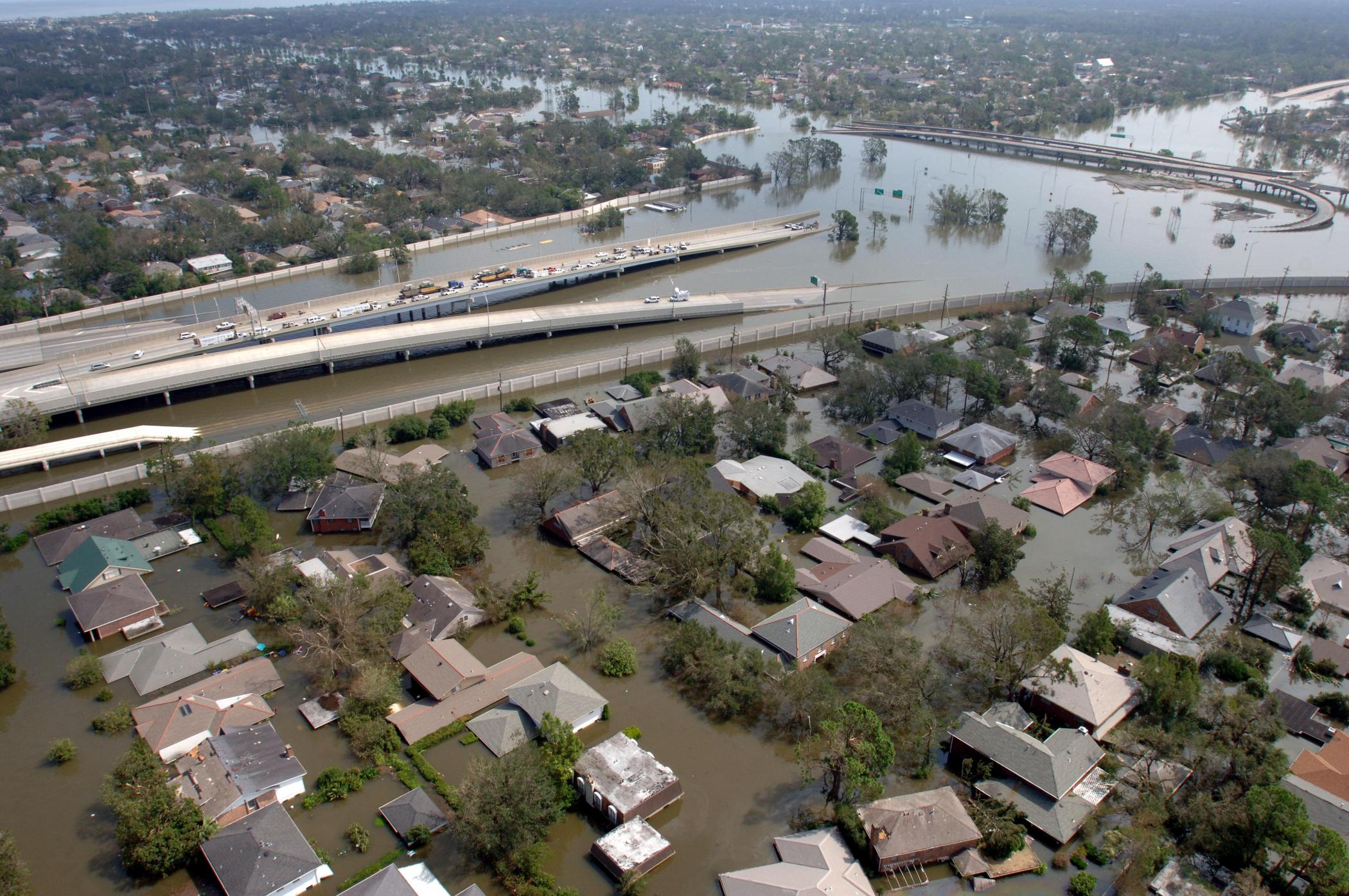
Flooded houses and highways in New Orleans (Jocelyn Augustino, FEMA)
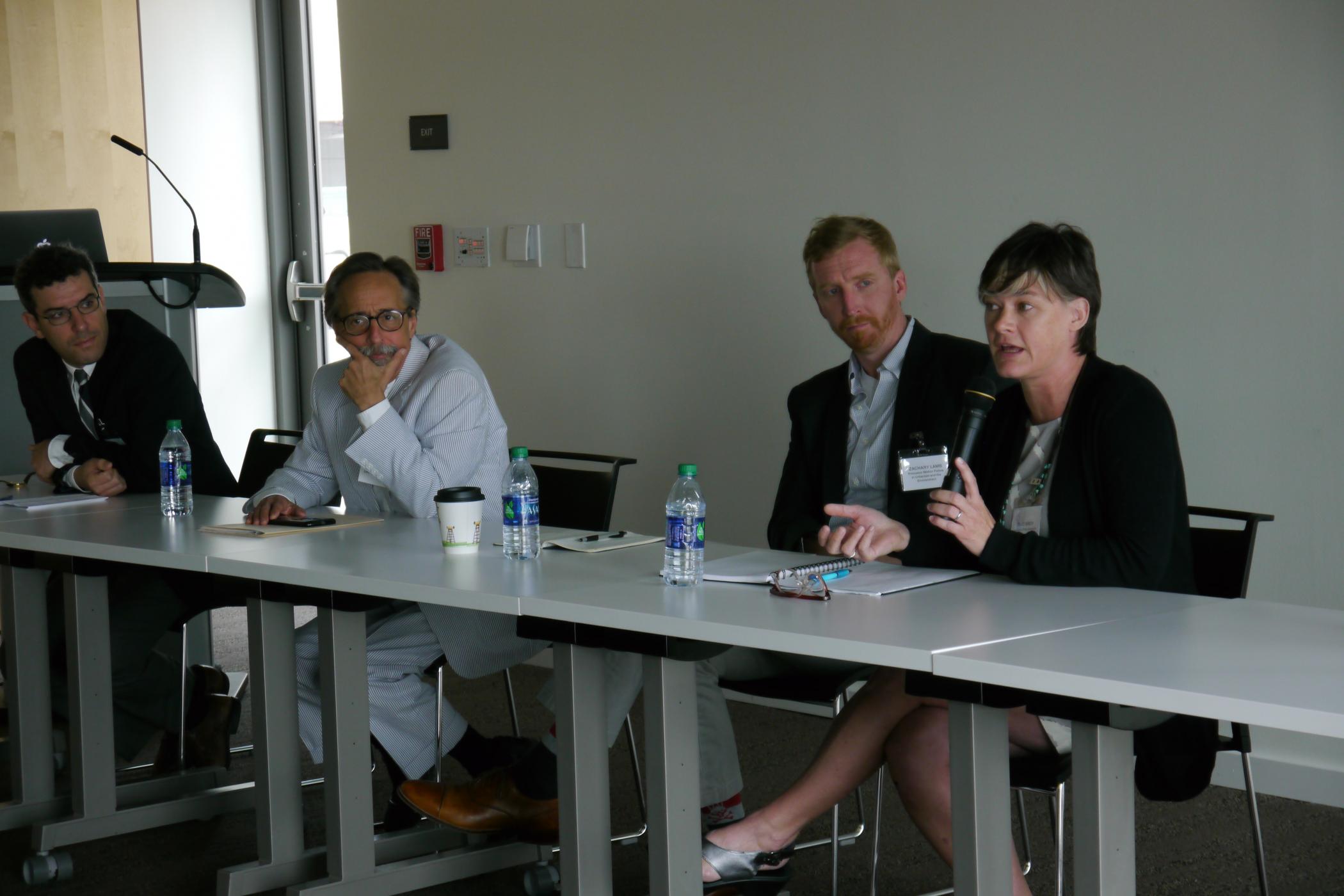
Traci Birch on the "Defining and Managing Risk" Panel Discussion
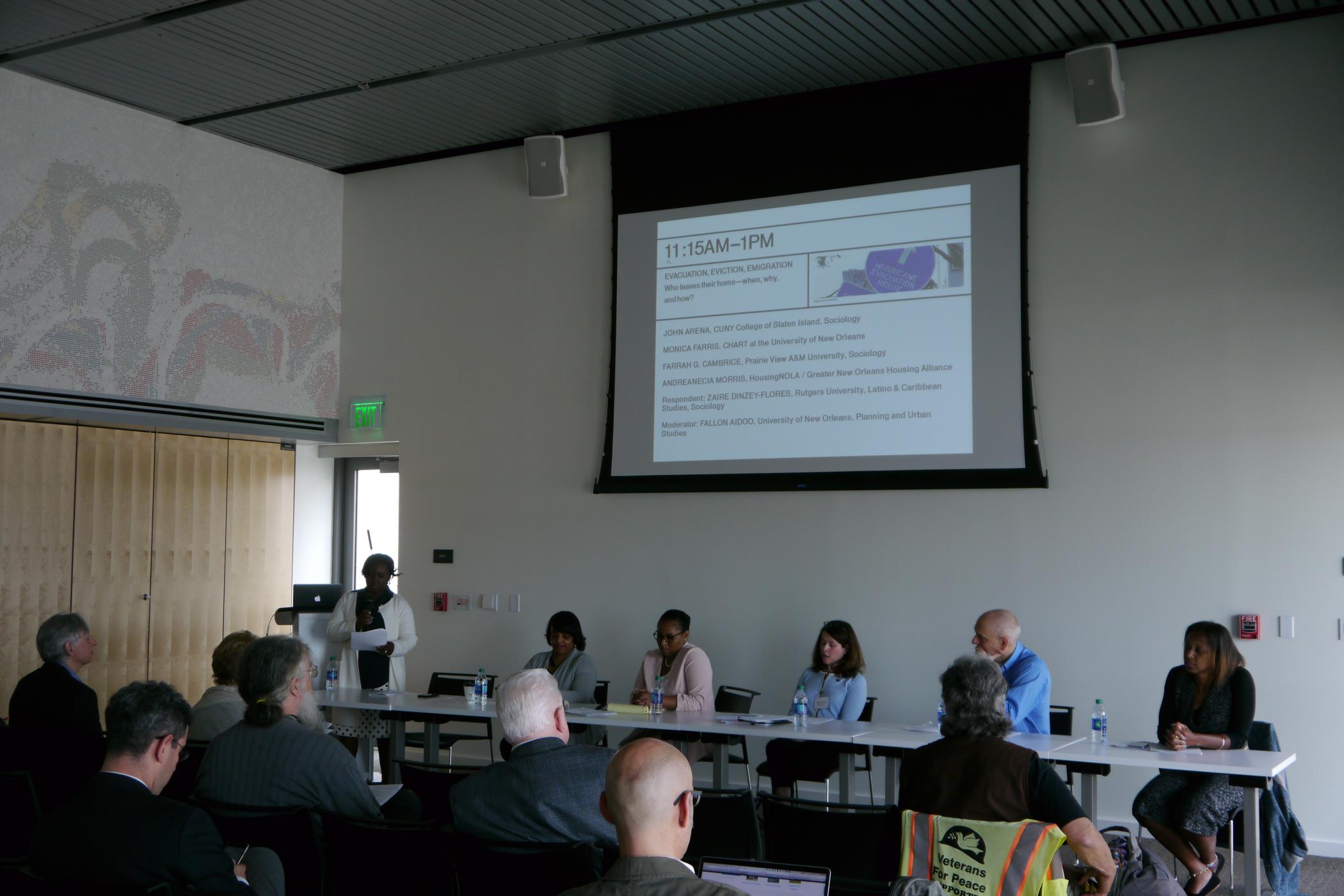
Fallon Aidoo introducing "Evacuation, Emigration, Eviction" Panel
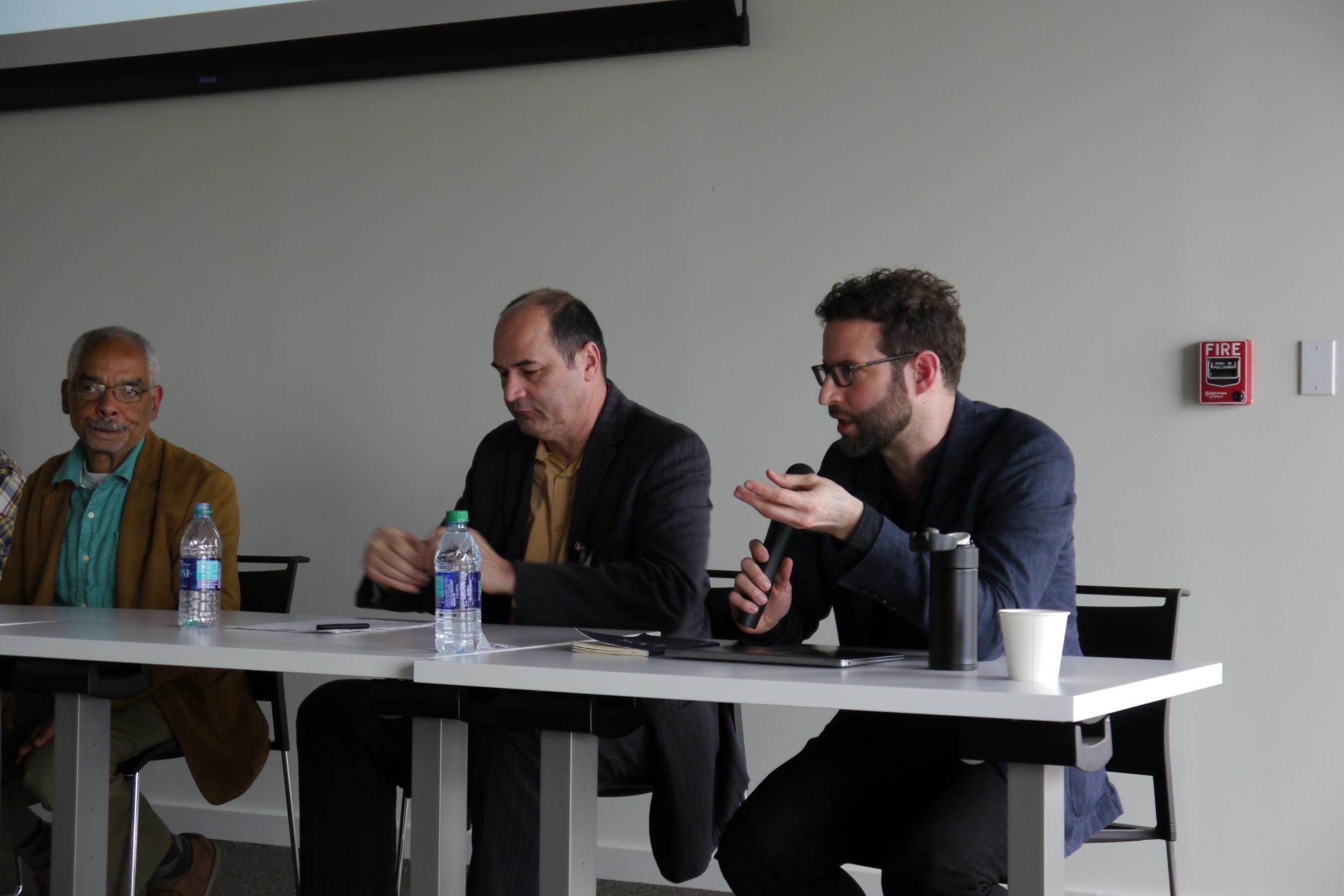
Daniel Aldana Cohen on the "Greenwashing" Panel
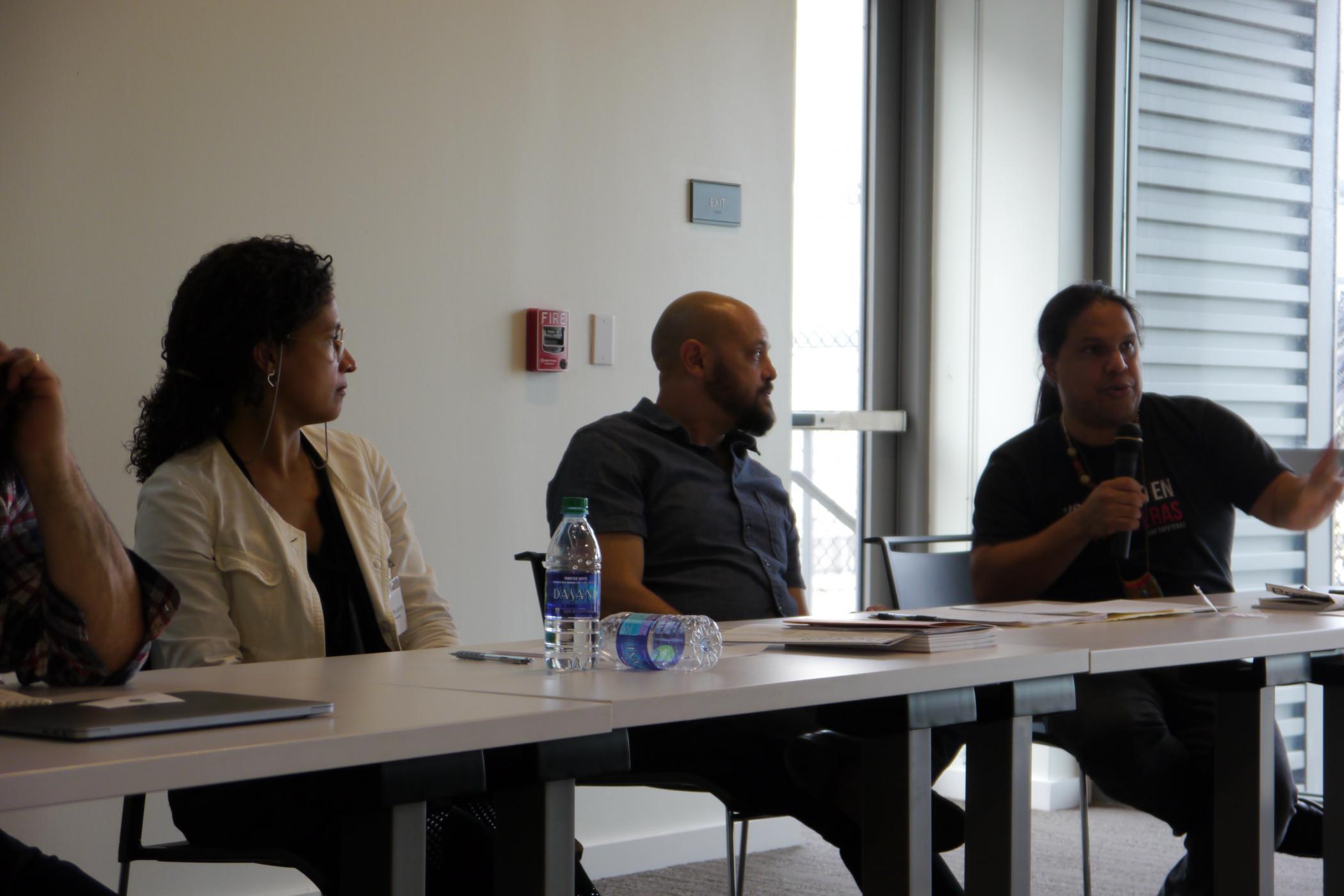
Bryan Parras on the "Is This Democracy?" Panel
Professional Practice and Green Reconstruction
2021 ACSA/EAAE Teachers Conference
Curriculum for Climate Agency: Design (in)Action
The teaching of “professional practice” has been standard in US graduate architecture programs for decades. In the National Architectural Accrediting Board’s 2020 update to their “Conditions for Accreditation,” professional practice was defined as “professional ethics, the regulatory requirements, the fundamental business processes relevant to architecture practice in the United States, and the forces influencing change in these subjects.”
The promise of professional expertise under “Green Reconstruction” is a double-edged sword for which new pedagogical models are necessary. How might architects’ roles as community and client advocates be taught in a context of ever-more competitive and specialized professional market shares of "service provision?" Where in the technical, aesthetic, and fiscal chain of architectural operations between the mouse and the jobsite does ethical, professional responsibility lie? Who should be held accountable in the profession for the very composition of the profession, considering glaring racialized, gendered, and economic disparities (among others), and how might that accountability be designed and sustained? What counts as “best” business practice in an economy and profession where wealth’s default flows are increasingly from those who need it most toward those who need it least? And for all of these: who decides? In this special session, faculty members and organizers from institutions shifting their professional practice curricula shared their motivations, methods, and challenges when addressing these and other questions before opening the conversation up to all attendees.
Moderator:
Jacob Moore, Associate Director, Buell Center
Speakers:
Rebecca Berry, Massachusetts Institute of Technology
Robert Mohr, Massachusetts Institute of Technology
Carisima Koenig, Pratt Institute
Kwesi Daniels, Tuskegee University
Megan Groth, Woodbury University
The June 2021 Teacher’s Conference, "Curriculum for Climate Agency," as a collaboration between the European Association for Architectural Education (EAAE) and the Association of Collegiate Schools of Architecture (ACSA), welcomed a range of formats for presentation and communication, from full‐paper and project-based presentations, to workshop‐based interactions, to graphic, visual and/or textual analyses of projects that responded to the ten scholarship themes. More information about the conference can be found here.
Designing a Green New Deal
"Designing a Green New Deal" brought together a broad array of voices, placing economists, historians, and designers in conversation with journalists, organizers, elected officials, and other parties engaged in organizing for climate action. This event served as the launch of a broader Green New Deal and the built environment research initiative at the University of Pennsylvania's McHarg Center.
This event was held when the country was entering a period of once-unfathomable hope on climate change. Grassroots movements and their allies in Congress, led by the insurgent millennial Alexandria Ocasio-Cortez, were staking out an ambitious agenda that matched the scale and urgency of the climate crisis. These new leaders were articulating their vision in terms of a Green New Deal—a still-abstract set of proposals for decarbonizing the economy, eliminating poverty, creating green, working-class jobs, and retrofitting communities for the coming effects of climate change. Decarbonizing the U.S. economy would be a massive boost to the fundamentally international project of preventing runaway climate change. Domestically, a Green New Deal would constitute a generational investment in planning and design, reshaping the social and physical landscape of the U.S. in ways matched only by the Industrial Revolution, New Deal, and postwar suburban boom. But the debates around fleshing out the Green New Deal vision have been relatively silent on its enormous implications for the built environment. And there is too little dialogue between Green New Deal proponents and the planning and design professions.
Here we sit, in the throes of a new generation’s ecological crisis, buoyed by an ascendant and broad-based progressive movement, as the most ambitious and interesting environmental and design proposal of the last half-century, a Green New Deal, gains momentum. The entirety of the built environment is at stake. And the design professions—for all of their self-important rhetoric about leading on climate—are missing in action.
A national-scale landscape transformation is coming. We'll all have to decide how best to manage and guide that process. Designers must choose if they want to be an active part of the coalition driving this change in the built environment. If they do, they will have to change the way they operate, becoming public servants as they were during the New Deal. They would also gain the chance to bring extraordinary skills to bear on literally rebuilding the country. Creating landscapes of genuine economic and racial equality will require both mass mobilization and the best possible technical expertise.
